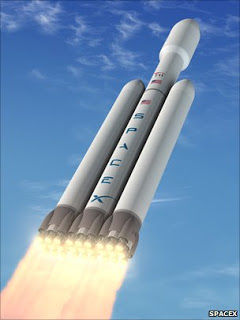SpaceX’s Falcon-9 Heavy rocket will have a launch capacity of 53 metric tons to low Earth orbit. This means that if a conventional hydrogen-oxygen chemical rocket upper stage were added, it could send 17.5 tons on a trajectory to Mars, placing 14 tons in Mars orbit, or landing 11 tons on the Martian surface.
The company has also developed a crew capsule, known as the Dragon, which has a mass of about eight tons. While its current intended mission is to ferry up to seven astronauts to the International Space Station, the Dragon’s heat shield system is capable of withstanding re-entry from interplanetary trajectories, not just from Earth orbit. It is rather small for an interplanetary spaceship, but it is designed for multiyear life, and it should be spacious enough for two astronauts with the right stuff.
Thus a Mars mission could be accomplished with three Falcon-9 Heavy launches. One would deliver to Mars orbit an unmanned Dragon capsule with a kerosene/oxygen chemical rocket stage of sufficient power to drive it back to Earth. This is the Earth Return Vehicle.
A second launch would deliver to the Martian surface an 11-ton payload consisting of a two-ton Mars Ascent Vehicle employing a single methane/oxygen rocket propulsion stage, a small automated chemical reactor system, three tons of surface exploration gear, and a 10-kilowatt power supply, which could be either nuclear or solar.
The Mars Ascent Vehicle would carry 2.6 tons of methane in its propellant tanks, but not the nine tons of liquid oxygen required to burn it. Instead, the oxygen could be made over a 500-day period by using the chemical reactor to break down the carbon dioxide that composes 95% of the Martian atmosphere. Using technology to generate oxygen rather than transporting it saves a great deal of mass and provides power and unlimited oxygen once the crew arrives.
The third launch would then send a Dragon capsule with two astronauts to Mars. The capsule would carry 2,500 kilograms of consumables—sufficient, if water and oxygen recycling systems are employed, to support the two-person crew for up to three years. Given the payload capacity, a light ground vehicle and several hundred kilograms of science instruments could be taken along as well.
The crew would reach Mars in six months and land their Dragon capsule near the Mars Ascent Vehicle. They would spend the next year and a half exploring.
Using their ground vehicle for mobility and the Dragon as home and laboratory, they could search the Martian surface for fossil evidence of life that may have existed when the Red Planet featured standing bodies of water. They could also assemble drilling rigs to bring up samples of subsurface water, within which native microbial life may persist. Finding either would prove that life is not unique to Earth, answering a question that mankind has wondered about for millennia.
At the end of their 18-month stay, the crew would transfer to the Mars Ascent Vehicle, take off and rendezvous with the Earth Return Vehicle in orbit. This craft would then take them on a six-month flight back to Earth, splashing down to an ocean landing.
Nothing in this plan is beyond our current technology, and the costs would not be excessive. Falcon-9 Heavy launches are priced at about $100 million each, and Dragons are cheaper. With this approach, we could send expeditions to Mars at half the cost to launch a Space Shuttle flight.
There is no question that this plan involves considerable risk, and a variety of missions, technology developments and testing programs in advance might reduce that risk.
The Falcon 9 Heavy is scheduled for its first flight in 2013. All of the other hardware elements in this plan could be made ready for flight within the next few years. NASA’s astronauts have gone nowhere new since 1972, but these four decades of wasteful stagnation need not continue. If President Obama were to act decisively and embrace this plan, we could have our first team of human explorers on the Red Planet by 2016.
It would appear that SpaceX, with its small payroll and new low-cost technology, could easily undercut such rivals as United Launch Alliance and Arianespace and still make mouthwatering amounts of money. But evidently Musk will be inclined to cut prices well below the short-term optimum: and that he will want to plough a lot of his profits into long-term future projects rather than using them to create a crowdpleasing balance sheet in the short term.
Musk would doubtless argue that market share – and, down the road, share of enlarged or even entirely new markets – is better than short-termist profiteering even in financial terms let alone altruistic ones. Nonetheless it would seem that those seeking a quick buck would do well to look elsewhere.
Dubbed Mayflower, the microsat rode the Falcon 9 to an elliptical orbit averaging 285 km (180 mi.) in altitude, validating an “advanced solar cell deployment system” and collecting baseline design data for future flights at higher altitudes, Northrop Grumman said May 11.






